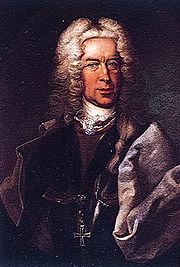
Guido Starhemberg
Encyclopedia

Austria
Austria , officially the Republic of Austria , is a landlocked country of roughly 8.4 million people in Central Europe. It is bordered by the Czech Republic and Germany to the north, Slovakia and Hungary to the east, Slovenia and Italy to the south, and Switzerland and Liechtenstein to the...
n military officer.
He was a cousin of Ernst Rüdiger von Starhemberg
Ernst Rüdiger von Starhemberg
Count Ernst Rüdiger von Starhemberg was the army commander of Vienna during the second siege of Vienna in 1683, imperial general during the Great Turkish War and President of the Hofkriegsrat.Starhemberg fought in the 1660s under Raimondo Montecuccoli against the French and the Turks.In 1683 he...
(1638-1701), the famous commander of Vienna
Vienna
Vienna is the capital and largest city of the Republic of Austria and one of the nine states of Austria. Vienna is Austria's primary city, with a population of about 1.723 million , and is by far the largest city in Austria, as well as its cultural, economic, and political centre...
during the Turkish
Ottoman Empire
The Ottoman EmpireIt was usually referred to as the "Ottoman Empire", the "Turkish Empire", the "Ottoman Caliphate" or more commonly "Turkey" by its contemporaries...
siege of 1683, and acted as his ADC during the siege. Guido followed his cousin, and later Prince Eugene of Savoy
Prince Eugene of Savoy
Prince Eugene of Savoy , was one of the most successful military commanders in modern European history, rising to the highest offices of state at the Imperial court in Vienna. Born in Paris to aristocratic Italian parents, Eugene grew up around the French court of King Louis XIV...
, in battles against the Turks.
In the War of the Spanish Succession
War of the Spanish Succession
The War of the Spanish Succession was fought among several European powers, including a divided Spain, over the possible unification of the Kingdoms of Spain and France under one Bourbon monarch. As France and Spain were among the most powerful states of Europe, such a unification would have...
Starhemberg fought in Italy and Spain. Between 1706 and 1708 he was the commander-in-chief of the imperial army in Hungary, since this time he led the operations against the insurgents of Francis II Rákóczi
Francis II Rákóczi
Francis II Rákóczi Hungarian aristocrat, he was the leader of the Hungarian uprising against the Habsburgs in 1703-11 as the prince of the Estates Confederated for Liberty of the Kingdom of Hungary. He was also Prince of Transylvania, an Imperial Prince, and a member of the Order of the Golden...
. In 1708 he was appointed Supreme commander of the Austrians in Spain.
Together with James Stanhope
James Stanhope, 1st Earl Stanhope
James Stanhope, 1st Earl Stanhope PC was a British statesman and soldier who effectively served as Chief Minister between 1717 and 1721. He is probably best remembered for his service during War of the Spanish Succession...
he succeeded in conquering Madrid
Madrid
Madrid is the capital and largest city of Spain. The population of the city is roughly 3.3 million and the entire population of the Madrid metropolitan area is calculated to be 6.271 million. It is the third largest city in the European Union, after London and Berlin, and its metropolitan...
in 1710, after the victories of Almenar and Saragossa
Battle of Saragossa
The Battle of Saragossa took place on 20 August, 1710, between the Spanish-Bourbon army commanded by the Marquis de Bay and a multinational army led by the Austrian commander Guido Starhemberg during the War of the Spanish Succession.-Prelude:...
.
But in December he was forced to leave the city by the lack of support by the people of Madrid for the Habsburg
Habsburg
The House of Habsburg , also found as Hapsburg, and also known as House of Austria is one of the most important royal houses of Europe and is best known for being an origin of all of the formally elected Holy Roman Emperors between 1438 and 1740, as well as rulers of the Austrian Empire and...
pretender. After the defeats at the Battle of Brihuega
Battle of Brihuega
The Battle of Brihuega took place on 8 December 1710 in the War of the Spanish Succession, during the allied retreat from Madrid to Barcelona...
and the Battle of Villaviciosa
Battle of Villaviciosa
The Battle of Villaviciosa took place on December 10, 1710, between the Franco-Spanish army led by Louis Joseph, Duke of Vendôme and Philip V of Spain and the Habsburg-Allied army commanded by the Austrian Guido Starhemberg during the War of the Spanish Succession, one day after the decisive...
(1710), he had to pull back to Catalonia
Catalonia
Catalonia is an autonomous community in northeastern Spain, with the official status of a "nationality" of Spain. Catalonia comprises four provinces: Barcelona, Girona, Lleida, and Tarragona. Its capital and largest city is Barcelona. Catalonia covers an area of 32,114 km² and has an...
, where he was made viceroy, when Archduke Charles
Charles VI, Holy Roman Emperor
Charles VI was the penultimate Habsburg sovereign of the Habsburg Empire. He succeeded his elder brother, Joseph I, as Holy Roman Emperor, King of Bohemia , Hungary and Croatia , Archduke of Austria, etc., in 1711...
returned to Austria.
After the Peace of Utrecht (1713), archduke Charles, now Emperor Charles VI, ordered him to abandon Catalonia. He pulled back with his troops to Genoa
Genoa
Genoa |Ligurian]] Zena ; Latin and, archaically, English Genua) is a city and an important seaport in northern Italy, the capital of the Province of Genoa and of the region of Liguria....
on English ships.
When he died in 1737, he was Governor of Slavonia
Slavonia
Slavonia is a geographical and historical region in eastern Croatia...
.

